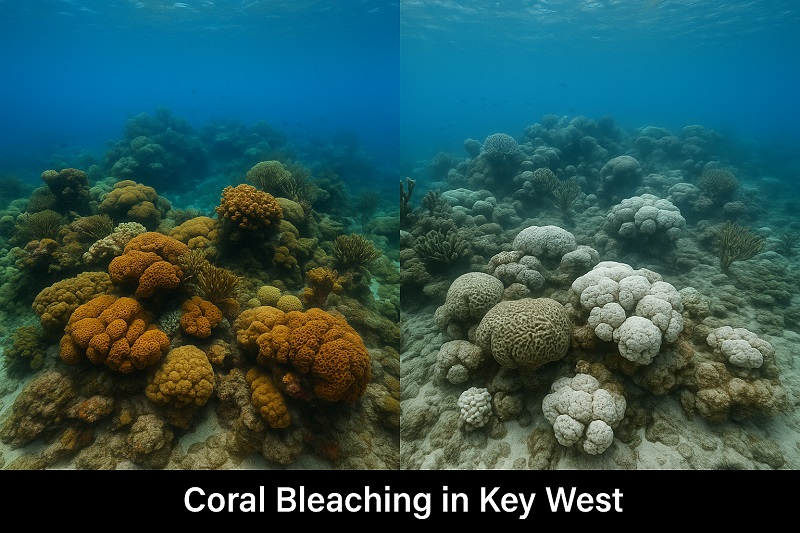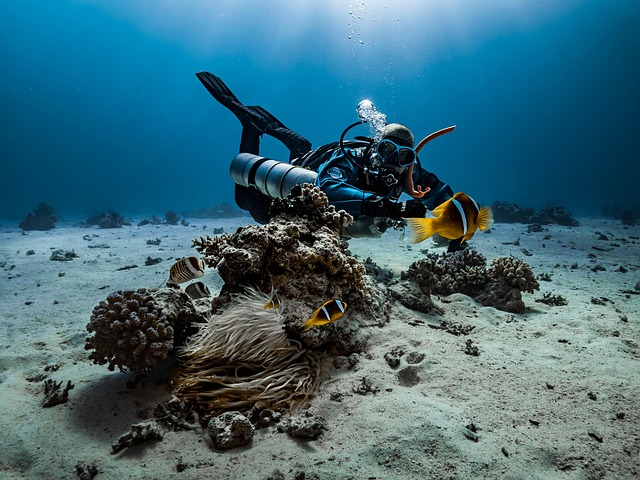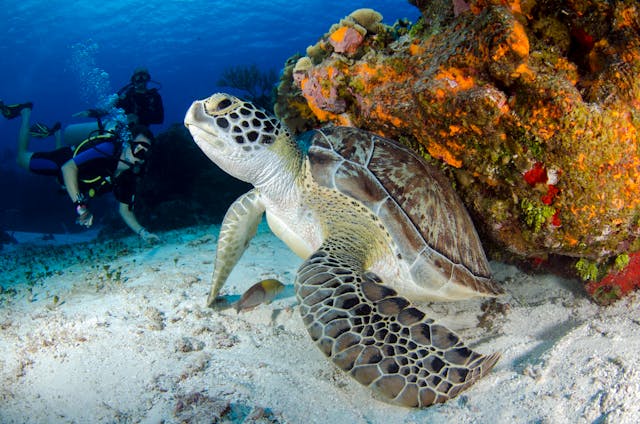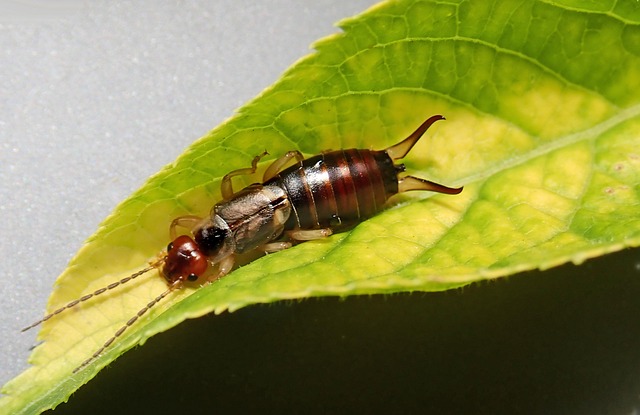What Makes Key West’s Ocean Ecosystem So Special?
Key West is at the edge of North America’s only living coral barrier reef, surrounded by marine life, seagrass beds and shallow mangrove estuaries. Its ocean ecosystem is as biologically rich as it is fragile—requiring conservation efforts and responsible tourism to keep it thriving.
The Ocean of Key West
Key West is the southernmost point in the continental U.S., surrounded by clear blue water and marine habitats. The Atlantic Ocean and Gulf of Mexico meet here, supporting an ecosystem with over 500 fish species, dolphins, sea turtles, manatees and a wide variety of coral and sponge life.
In the shallow backcountry waters, seagrass meadows and mangroves are nurseries for young marine life, while the deeper reef structures are hunting grounds for adults. Together these habitats form one of the most important marine ecosystems in the Western Hemisphere.
Coral Reefs: The Fragile Giants of the Keys
Just a few miles offshore lies the Florida Reef Tract—the third largest coral barrier reef system in the world. Made up of hard and soft corals, this reef is the lifeblood of Key West’s marine biodiversity.
But these coral giants are in trouble. Rising ocean temperatures have caused mass bleaching. Pollution from sunscreen, boat anchors and untreated wastewater has further stressed the coral. Ocean acidification and disease has only accelerated the decline.
Organizations like the Coral Restoration Foundation and NOAA are working to replant coral fragments, monitor reef health and educate the public. Their work is more important than ever as the world warms up.
Interdependence: Coral, Seagrass, and Mangroves as One System
| Habitat | Key Services | What Happens if Lost? |
| Coral reefs | Wave buffering, fish nursery, tourism magnet | Coastal erosion; fisheries collapse |
| Seagrass beds | Carbon capture, water filtration, manatee grazing | Water clarity plummets; carbon released |
| Mangroves | Storm surge shield, juvenile fish refuge | Shoreline retreat; biodiversity decline |

Threats and Triumphs: Conservation in Action
1. Mounting Threats
Key West’s ocean realm is under pressure from four, overlapping stressors:
| Major Stressor | Impact on the Ecosystem | Recent Evidence (2023-24) |
| Climate change & heatwaves | Mass‐bleaching, coral mortality, stronger hurricanes | A July 2023 thermal anomaly pushed reef temperatures >32 °C for three weeks, triggering the worst bleaching on record. |
| Overfishing & by-catch | Predator imbalances, reef-fish decline | NOAA stock assessments list Nassau grouper as critically overfished in the Keys. |
| High-volume tourism | Anchor breakage, sunscreen pollution, wildlife harassment | Pre-COVID peaks saw >3 million visitors/year; 60 % of anchor scars on shallow patch reefs are tourism-related. |
| Marine debris & micro-plastics | Entanglement, ingestion, habitat smothering | Local clean-ups remove 20+ tons of trash annually; 80 % is single-use plastic. |
2. Turning the Tide—Success Stories
- Coral out-planting: The Coral Restoration Foundation has transplanted >100,000 nursery-grown corals since 2012, with monitored survival rates now climbing above 70 % when sited below 8 m depth.
- Reef-safe sunscreen bans: Key West’s 2019 ban on oxybenzone and octinoxate reduced those chemicals in near-shore waters by 72 % in three years.
- Citizen science: Programs such as Reef Relief’s “Adopt-A-Coral” have logged 15,000 volunteer survey dives, adding real-time data to NOAA’s Coral Watch network.
- Ghost-gear removals: Dive groups removed 11 derelict lobster traps and 1,600 m of fishing line from Western Sambo Reef in 2024, instantly improving live-coral cover by 3 %.
3. Marine Protected Areas—Policy Meets Practice
Almost the entire island chain sits inside the Florida Keys National Marine Sanctuary (2,900 nmi²), but Sanctuary Preservation Areas (SPAs) and recently expanded “No‐Anchor” corridors provide the real frontline defense:
- No-take SPAs now cover 7 % of reef habitat, reducing fishing pressure on spawning aggregations.
- Post-hurricane “Reef Insurance” payouts (funded via a $1 eco-fee added to certain tour tickets) financed emergency coral stabilization after Hurricane Ian.
- A 2025 NOAA proposal aims to link all SPAs into a continuous 30 × 30 corridor, giving heat-resistant “super-coral” out-plants the best chance to seed adjacent, still-vulnerable reef patches.
These layered measures—science, grassroots action, and enforceable zoning—show that even a heavily visited reef can rebound when threats and triumphs are managed as one story.
Responsible Travel in the Age of Climate Risk
Why Low-Impact Choices Matter
- Tourism powers ~50 % of Key West’s economy, yet every gallon of boat fuel, plastic cup, or stray anchor leaves a carbon or physical scar. With sea level projected to rise 6–12 in (15–30 cm) by 2045, today’s visitor either lightens the load or accelerates the tipping point.
Carbon math: A four-hour diesel snorkel boat releases ~115 kg CO₂; an electric catamaran releases near-zero, offset only by grid charging—proof that upgrading your excursion truly shrinks the footprint.
Travel Responsibly—A Quick Checklist
| Do This | Why It Helps |
| Choose reef-safe, mineral sunscreen (non-nano zinc or titanium). | Prevents chemical bleaching and coral DNA damage. |
| Skip mega-ship day trips or crowds >20. | Eases dock congestion, wastewater spikes, and wildlife stress. |
| Pack out—even micro-trash. | Plastics photodegrade into ingestible fragments within weeks. |
| Use refillable bottles & reef-safe soaps. | Cuts single-use plastics and nutrient runoff. |
Spotting a Genuine Eco-Tour
- Propulsion: Electric, solar-assist, or biodiesel engines.
- Crew training: Onboard marine biologist or Naturalist Association certification.
- Group size: ≤12 guests means better interpretation and smaller wake wash.
- Gear policy: Reusable water bottles, silicone snorkels, no single-use plastics.
- Wildlife code: Passive observation—no feeding, touching, or flash photography.
Transition to exemplar:
Several operators meet (and exceed) these criteria, but Honest Eco’s all-electric catamaran—featured on PBS and National Geographic—has become the gold standard. Their guided boat tours in Key West blend dolphin science, coral etiquette, and zero-waste service, proving that sustainability can be the trip highlight, not a compromise.
By aligning personal choices with these best practices, every traveler becomes part of the reef’s recovery team—shrinking carbon footprints, funding conservation, and ensuring that Key West’s turquoise legacy survives the climate trials ahead.
A Model for Sustainable Marine Excursions
One standout in the region is Honest Eco, an award-winning eco-tour company based in Key West. They offer dolphin-watching tours, snorkeling trips, and backcountry explorations using a custom-built electric catamaran—the first of its kind in the U.S.
With zero emissions, reusable water bottles, and a zero-waste policy, Honest Eco is setting the standard for marine excursions that are both educational and environmentally responsible. Their staff includes marine biologists who help guests understand the unique behaviors of dolphins, reef fish, and coral ecosystems.
Their model shows that sustainability and profitability can coexist—and thrive.
Community-Driven Conservation
Local NGOs like Reef Relief and MOTE Marine Laboratory run citizen-science coral surveys, while Key West Marine Park has volunteer kayak trash-patrol days. Joining even a two-hour cleanup embeds visitors in the protection story.
Educational Opportunities: Learning While Exploring
- Voluntourism packages: help plant coral fragments, then track their growth online
- Student reef-ID workshops: snorkel with laminated species cards and upload sightings to iNaturalist
- “Living classroom” paddles through mangroves, mapping juvenile fish nurseries for NOAA scientists

Responsible Snorkeling & Diving: Visitor Code of Conduct
- Float—don’t stand—over coral.
- Maintain a two-meter buffer from turtles, rays, and dolphins.
- Rinse gear with fresh water to prevent disease spread between sites.
- Consider a snorkel vest: conserves energy, prevents accidental reef kicks.
- Avoid flash photography with nocturnal species.
Policy & the Future: Safeguarding Waters to 2030 and Beyond
- NOAA 30×30 Plan: expand marine protected areas and “no-anchor” zones.
- Reef Insurance Schemes: using tourism fees to fund post-hurricane restoration.
- AI Monitoring: autonomous drones scanning reefs for early disease detection.
What You Can Do as an Eco-Conscious Visitor
Every traveler has a role to play in protecting Key West’s ocean ecosystem:
- Use reef-safe, biodegradable sunscreen.
- Bring reusable water bottles and containers.
- Support eco-certified businesses.
- Leave no trace—pack out what you pack in.
- Volunteer for a reef or beach cleanup during your visit.
- Educate others on sustainable travel practices.
Even small actions can add up when multiplied by thousands of visitors each year.
Final Thoughts: Protecting Paradise, One Trip at a Time
Key West’s beauty is more than skin deep—it’s alive in the coral reefs, echoing through the dolphin clicks, and pulsing in the turquoise tides. But this paradise is delicate, and its future depends on thoughtful, intentional tourism.
By choosing responsible experiences like eco-certified boat tours in Key West, you’re not just sightseeing—you’re supporting a living ecosystem and becoming part of its preservation story.
So go ahead, explore. But do it wisely. Because paradise is worth protecting.




